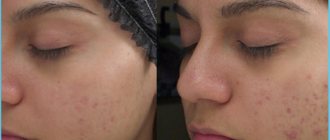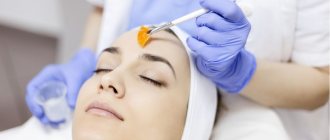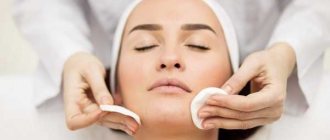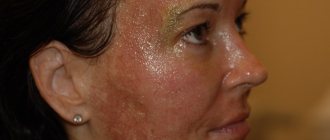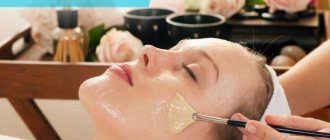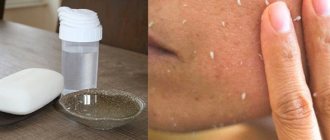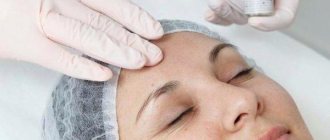The principle of Jessner chemical peeling - key features of the procedure
Jessner peeling, similar to any other cosmetic procedure, involves several stages of implementation:
- The master determines the individual intolerance of the composition by the client’s body.
- Next, the skin is cleaned, usually using a special solution that provides a disinfecting effect, removing residual sebum.
- After the cleaning procedure, the peeling solution is carefully applied using a cotton or gauze swab. It is quite normal to experience a burning sensation throughout the procedure as the top layer of skin is removed. Mild discomfort is certainly present, but is fully compensated by the result of the procedure.
- Applying a special solution to neutralize the effect of the solution, removing any remaining product.
Within a week after the procedure, there will be a problem of skin redness, peeling, followed by peeling off in layers. Such changes are actually something to keep in mind because not everyone is ready to go outside with such changes. But it’s worth being patient for a week to achieve the complex effect of complete skin renewal, gaining an image of beauty, health and youth. After 2-3 weeks, it is recommended to repeat the procedure. This course is carried out 4-5 more times to consolidate the effect. However, the duration of the course is determined individually for each client; for many, 2-3 procedures are enough.
Jessner peel protocol Salicylicpeel JS Medic Control Peel
Stage I. Pre-peeling preparation
For 14–21 days, the patient should apply Prepeel Active cream to skin previously cleansed with CleanserMousse. In the morning, you must apply MediScreen sunscreen.
Stage II. Chemical peeling
1 step.
Cleansing.
Apply Cleanser Mousse to the skin, distribute with light massage movements and leave for 15-20 seconds. Rinse with water. Step 2.
Degrease the skin with Prepeel Lotion.
Step 3.
Apply Salicylicpeel JS with cotton pads with quick movements (the cotton pad is moistened directly from the bottle) onto the entire facial skin in the following sequence: forehead, temples, chin, cheeks, nose, eyelids.
During application of the drug, the patient feels a burning sensation. After 2-3 minutes, the liquid fraction evaporates and a white coating formed by salicylic acid crystals appears on the skin. By the homogeneity of the plaque, one can judge the uniformity of application of the peeling composition to all treated areas. Do not rinse off. Then you can apply the next layer. The number of layers is determined by the individual characteristics of the patient’s skin, indications, as well as the desired depth of penetration. Leave for 4 hours. Step 4
Ask the patient to wash.
If the aggressive effect is pronounced, the peeling composition can be washed off earlier.
Step 5 Apply Vegefarma cream to the skin.
Stage III. Post-peeling care
for 5-7 days after the Jessner peel procedure.
Vegefarma cream and in the morning protect from ultraviolet radiation by applying MediScreen sunscreen.
Expected reactions after peeling
Immediately after applying the peeling composition, a pronounced burning sensation is noted, erythema is observed, on days 2–4 the skin becomes parchment-like, on days 3–4 severe peeling begins, which continues until days 6–7. 2 days after the procedure, desquamation begins, which lasts 5-7 days. It is necessary to warn the patient about the inadmissibility of forcible removal of crusts or film that have appeared.
Jessner peeling is carried out in two levels. The procedure can be median or superficial:
- Superficial - the procedure is based on applying only one layer of solution, keeping it on the surface for a short time to ensure deep penetration into the composition of the epidermis. As a rule, a procedure is performed to prepare the skin for medium peels. The skin after the superficial procedure does not imply significant peeling.
- The middle procedure is working with three or more amounts of solution. In this case, the skin after peeling begins to turn red, the next day it completely acquires a brown tint, covered with a crust or film, with tightening, with severe peeling and flaking after a few days.
Types of peeling by depth of influence
The choice of peeling depth depends on the patient’s indications and goals.
Surface
A relatively popular type of peeling, which is carried out for the purpose of:
- getting rid of age spots;
- equalization of tone and relief;
- eliminating traces of acne.
Superficial peeling can be carried out in a course, as well as in preparation for a medium TCA peel.
Median
Medium peeling can correct significant defects: these can be scars, severe hyperpigmentation of the facial skin, and traces of post-acne.
Features and rules of care after Jessner peeling
To achieve the desired effect, it is important not only to the quality of the procedure, but also to proper care after peeling. To do this, the cosmetologist explains in detail to the client the step-by-step procedure, with recommended products and preparations for caring for the skin condition.
- Be sure to strictly follow the recommendations and instructions of the cosmetologist.
- After peeling, it is unacceptable to wash your face for 12 hours.
- Usually, a cosmetologist individually selects a set of products for intensive moisturizing and gradual restoration of the skin - the most important point for the desired effect, which should not be neglected.
- Only boiled water is suitable for washing; the surface of the skin should be wiped with blotting movements.
- You should temporarily abandon standard cosmetics and homemade masks. The bet should be made in favor of restorative, wound-healing creams and serums.
- The option of sunbathing is unacceptable; you can walk outside only if you apply a UV filter to your face with a high protection factor.
How is the procedure performed?
First, a sensitivity test is performed. Then the cosmetologist degreases the top layer of the epidermis and applies a composition with acids. Typically, the effects of acids will be felt as a slight burning sensation on the face. Then, when the composition dries, the specialist applies a mask to soothe the skin.
Thus, the procedure time depends on the intensity of the action of acids (for example: superficial or middle type), as well as on the number of layers of solution applied. On average, each of them is applied at an interval of 5 minutes.
It is worth noting that the duration of the procedure is about 60 minutes. The duration of action of the composition is from 3 to 5 hours, the remains of which are washed off by the patient at home, independently.
It is advisable to perform peeling in the autumn-winter period, at a time when sun activity is reduced. The number of procedures, as well as the depth of impact, are determined by a cosmetologist. Please note that the procedure has a cumulative effect. As a rule, the course varies from 2 to 6 sessions, the break is 4-6 weeks. The final result can be assessed in a month.
Consequences of peeling
Any exposure to acid to the skin involves tissue burns. If the situation gets out of the control of the peeling performer or he violates the technology of the procedure, the patient will face complications and unpleasant consequences.
All consequences of peeling can be divided into expected (predictable) and unexpected (complications).
The expected consequences of peeling are a normal reaction to the action of the chemical composition on the face. With proper skin care and compliance with all specialist recommendations, they will disappear without a trace during the rehabilitation period. Predicted consequences of chemical peeling include:
- erythema or redness of the facial skin;
- mild swelling of soft tissue in sensitive areas (under the eyes, around the mouth);
- darkening of damaged areas;
- peeling of the integument;
- increased skin sensitivity to cold, heat, cosmetic products, weather conditions and solar ultraviolet radiation.
Post-peeling complications are an unexpected reaction of the skin to the procedure, a deterioration in its condition. Only a specialist can find a solution to the consequences that arise; self-medication can further complicate the problem and lead to residual marks on the face, even deformity.
If you notice changes on your face that are unusual for the procedure, contact a specialist immediately. Remember, timely assistance will speed up the resolution of the problem.
The most common complications after a Jessner peel include:
- herpetic rashes on the face;
- the appearance of pimples, acne and other manifestations of infection of the integument;
- persistent erythema;
- signs of an allergic reaction;
- skin hyperpigmentation;
- residual scars and scars after tearing off the film on the face.
Complications and side effects
If the above recommendations are not followed, unpleasant consequences arise:
- severe redness;
- irritation;
- swelling;
- itching
After removing the peel, many women feel a slight burning sensation. There is no need to worry: this is how the skin reacts to acid exposure. The skin needs 5-6 days to recover, after which time you can admire the result of the procedure.
Some women have an allergic skin reaction to lactic acid. It is accompanied by:
- changes in skin color;
- the appearance of acne;
- swelling;
- itching;
- increased skin sensitivity;
- intense peeling;
- ulceration, the appearance of open wounds.
Allergy symptoms usually go away on their own after a week or two. If a woman does not follow hygiene rules, her allergies may worsen, and the likelihood of infection or exacerbation of herpes increases.
Are there any contraindications?
Although the use of peeling is quite common today and even Hollywood stars use it (which is why it is also called Hollywood), this type of procedure is not suitable for everyone.
First of all, people with the following problems should pay attention to such cleaning:
- acne and post-acne;
- rosacea;
- enlarged pores;
- increased secretion of the sebaceous glands;
- dark spots;
- wrinkles;
- scars, scars;
- loss of tone;
- black dots;
- comedones;
- freckles.
But cosmetologists recommend not to ignore contraindications for the procedure, ignoring which will not only not give the expected result, but can also worsen the condition of the skin and health. So, Jessner peeling is not suitable in the following cases:
- allergies;
- individual intolerance to at least one of the components included in the peeling;
- violation of the integrity of the skin surface;
- the presence of large moles, papillomas;
- skin diseases;
- burns;
- vein blockages;
- increased body temperature;
- carrying out chemotherapy procedures;
- during pregnancy and breastfeeding;
- oncology;
- diseases of the immune system.
Women with dark skin should be wary of this type of exfoliation. Since the effect of peeling is aimed, in particular, at whitening the skin. Therefore, before the procedure, you must consult with a cosmetologist. Frequent cleansing is also contraindicated for older people, since radical effects of active substances can lead to loss of turgor in weakened skin and the formation of a capillary network.
Number and frequency of procedures
Jessner peeling is performed in courses. This allows you to achieve amazing, lasting results. How often peeling can be done and how many procedures will be required is determined only by a specialist. This takes into account the degree of the problem, the client’s age and the condition of his skin.
On average, the recommended course involves 5-6 peels for sensitive epidermis, 8-10 for oily and problematic skin. They are carried out at intervals of 3–5 weeks. At the first visit, the cosmetologist performs superficial cleansing (applies 1–2 layers), then the number of layers increases.
The duration of the results from cleaning varies. Ideal, tightened skin can last from 10 days to 6 months. A role in this is played not only by the manufacturer of the product, the skills of the cosmetologist, but also by further facial care and compliance with the specialist’s recommendations.
Composition and benefits for the skin
Jessner's peeling product contains 3 main components:
- Concentrated salicylic acid or Salicylic acid. This ingredient has high anti-inflammatory, antiseptic, and keratolytic properties. The acid will be especially useful for fatty and problematic types of epidermis, due to its drying effect. It relieves and prevents possible inflammation and itching. The peeling preparation contains up to 14% salicylic acid.
- Concentrated lactic acid or Lactic Acid. The concentration of this ingredient is also 14%. Lactic acid has a multifaceted effect on the skin: moisturizes, whitens, soothes, tones, stimulates the production of natural collagen and elastin, and promotes trouble-free and rapid exfoliation of dead particles. It is easily perceived by the skin, because it is already contained in small quantities in the epidermal cells. Lactic acid is a balancer in the aggressive effects of salicylic acid and resorcinol, it softens their effect on the skin.
- Resorcinol or Resorcin. This component, in addition to exfoliating, antibacterial and whitening properties, binds previous acids to each other and enhances their effect. The concentration of resorcinol is 14%.
Attention! Resorcinol is very demanding on storage conditions, so you need to store the peeling drug in a tightly closed package with darkened glass, in a cool place.
The secret of the effectiveness and delicacy of Hollywood peeling lies in its composition. The ingredients of the peeling product harmoniously complement each other and guarantee a quick transformation with minimal risks of complications.
Contraindications
Not everyone can do a Jessner peel. The procedure will be abandoned if there is at least one contraindication. These include:
- allergies and individual intolerance to the components of the peeling product;
- active herpes and various infectious rashes;
- large moles in the treatment area;
- pregnancy, regardless of trimester;
- some skin diseases, demodicosis;
- rosacea mesh on the face;
- oncology, after chemotherapy;
- exacerbation of chronic ailments;
- feverish condition, general malaise;
- the skin is inflamed or not fully restored after previous cleansing, after facial surgery;
- wounds, cuts, purulent formations and injuries of various types;
- taking many medications, in particular retinoids, drugs with menthol and camphor;
- fresh tan
Jessner peeling is not recommended during menstruation, while breastfeeding or taking hormonal medications. Even minor hormonal disruptions in a woman’s body can negatively affect the outcome of the procedure.
If you have performed salicylic peeling before, and the procedure resulted in complications, you should notify your cosmetologist about this. There is a high probability that peeling with a salicylic-milk composition will also not work.
Those with dark skin should approach the procedure with caution. Deep exposure may cause a line of demarcation to appear on the face.
Neglecting contraindications is dangerous due to unpleasant consequences, the development of complications and deterioration of the condition of the epidermis. Therefore, before cleaning, consult a cosmetologist. A detailed examination of the condition of the integument and the patient as a whole makes it possible to prevent their occurrence.
The essence of the procedure
Jessner peeling is the process of freeing the pores on the facial skin from keratinized scales and accumulated sebum using a specially developed preparation.
The procedure is characterized by a shallow, gentle effect on the epidermis, so cases of side effects are recorded extremely rarely.
The product used in cosmetology for Jessener peeling was originally developed as an after-shave balm.
US Navy ship's doctor Jessener developed a miracle formula that was designed to disinfect the skin from bacteria transmitted by tactile means. As a result, an “acid” cream was obtained, which has excellent antiseptic properties.
The essence of the Jessner peeling procedure is a step-by-step effect on the epidermis:
- Stage 1. Cleansing and stimulation of metabolism at the cellular level.
- Stage 2. Lifting effect and elimination of wrinkles.
- Stage 3. Eliminates serious wrinkles, age spots, acne and eliminates skin irregularities.
Attention! The number of stages directly depends on the problems that need to be resolved. This peeling is chemical. First, the skin is cleansed, then it is exposed to acids, after which they need to be neutralized.
Indications
Indications for the use of Hollywood facial peeling are as follows:
- scars, scars and post-acne;
- age and expression wrinkles;
- decreased skin tone and turgor;
- unhealthy complexion, unusual dullness and grayness;
- enlarged and clogged pores;
- skin is excessively oily, prone to acne and acne;
- signs of early aging of the integument;
- comedones, blackheads;
- ingrown hair problem;
- hyperkeratosis;
- skin pigmentation of various types, including those caused by pregnancy;
- freckles;
- seborrheic dermatitis.
With Jessner peeling, you can refresh and heal the skin, and correct imperfections in the relief of the surface of the face. This can be done in a beauty salon or at home after a detailed study of the cleansing technique, and also in the absence of contraindications.
Efficiency of the procedure
To achieve visible results, you will need to complete a course of 10 sessions with an interval of 10 days. After the procedure, slight peeling and the formation of a brown crust are possible. But after you go through all the therapy, you will have smooth, uniform skin, without pimples and blackheads. A pleasant bonus will be a slight lifting effect and the elimination of wrinkles.
Important to know: There are several types of peeling: superficial - to eliminate acne and rosacea, super-superficial, aimed at eliminating minor skin defects and a small number of pimples, and medium penetration, which is designed to eliminate scars and improve the regeneration of the epidermis. The type of peeling is selected depending on the problem.
It is believed that after a successful procedure, the positive effect is delayed for a period of 4–8 months. Some women note that medium peeling is an excellent alternative to surgery.
